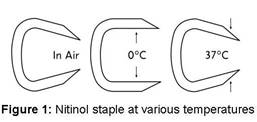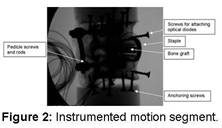| Medical Devices Home Exposition To Register ASM Homepage | |

|
|
||||
| Back to "Effect of Materials on Treatment & Surgical Techniques - Session 2" Search | Back to Main Search |
|||||
Introduction: DLIF procedures use side-implanted anterior support with posterior fixation. Disc must be removed to create a spacer pathway, so the potential for expulsion exists. A Nitinol staple could be useful in interbody containment due to its shape memory alloy material properties. The hypothesis was the staple would maintain position and share a minimal amount (< 10%) of the load.
Materials and Methods: Lumbar cadaveric segments were implanted laterally with a bone graft and Nitinol staple and posteriorly with pedicle screws/rods. Strain gauges affixed to the staple captured strain during testing. Three test states were evaluated: intact; fully-instrumented; and stand-alone (no graft or screws/rods). Staple strain ratio was stand alone/fully-instrumented state.
Results: In fully-instrumented tests, the staple maintained its position. The ratio of staple strain was much higher than expected.
 | ||
 | ||
| 8mm Staple | 14mm Staple |
Flexion-Extension | 15±14% | 20% |
Lateral Bending | 13±8% | 23% |
Axial Torsion | 11±9% | 6% |
Stand-alone specimens were evaluated with anterior and posterior structures intact. Studies have shown1,2 that these structures have substantial (>60%) contributions to overall spine loading. Adjusting the FE and AT load share accordingly, these values fell below 10%. Posterior contribution in LB is unknown, but the posterior elements are expected to share a portion of load in LB as well.
Table 2: Estimated True Load Share Percentages. *Unadjusted Percentages.
| 8mm Staple | 14mm Staple |
Flexion-Extension | 5.2±4.8% | 6.8% |
Lateral Bending | 13±8%* | 23%* |
Axial Torsion | 4.1±3.3% | 2.2% |
Conclusions: A staple manufactured from shape memory alloy Nitinol maintained its position when used for graft containment. When contributions of posterior elements were considered (when possible), the staple load share was minimal. In conclusion, the shape memory properties of the staple were deemed useful to the containment of interbody devices.
References:
1 Doehring et al. ORS. 2001
2 Adams et al. Spine 6(3): 241-248, 1981.